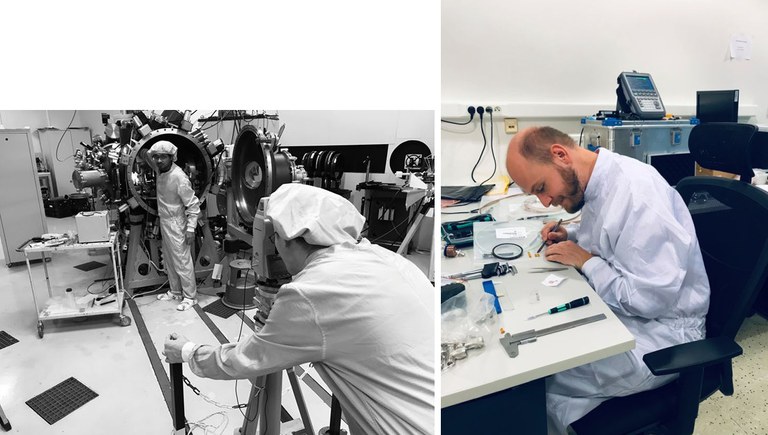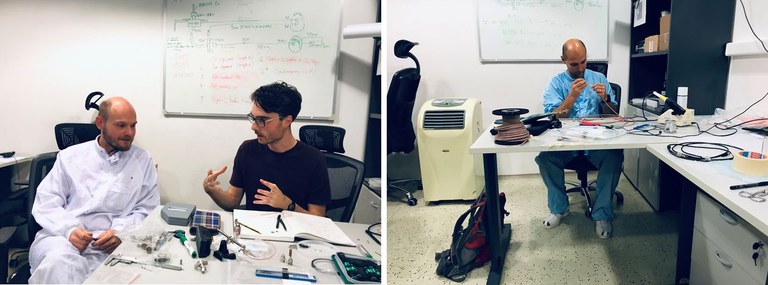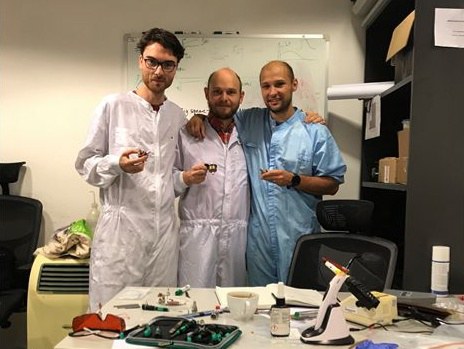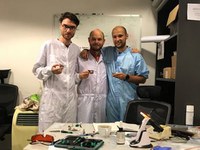A Fruitful Collaboration: Report of a Laserlab-Europe Staff Exchange at the Prague Asterix Laser System (PALS)
Few people are familiar with what goes on at a high power laser facility, when lasers are focused down to the width of a hair and burn bullet-holes through solid targets. Beginning as a livid pinprick in the dimness of the experimental vacuum chamber, so-called “high power” laser interactions are so intense that they can transmute targets into bright bubbles of plasma and tear electrons free from the surface of a material. A positive voltage builds up as more electrons are lost, driving a current out of the laser focus towards the nearest electrical ground, arrowing down the target mount into the vacuum chamber walls. These currents lightning to earth in a fraction of a second, leaving little behind except a violent burst of radio waves. Quantifying precisely how large these laser-driven currents are, how they evolve and their impact on the laser interaction, is extremely challenging. Scientists often rely on indirect measurement techniques like proton deflectometry to take “images” of the corresponding magnetic field structure, but results are often complicated to interpret and additional powerful laser beams are required to provide a suitable proton source.

Left: PhD student Shubham Agarwal and PALS staff scientist Dr. Michal Krupka
installing a Cu foil target prior to a laser shot.
Right: Dr. Michael Ehret making plastic-coated targets by hand.
This Laserlab Staff Exchange was conceived by Dr. Michael Ehret (CLPU), Dr. Jakub Cikhardt (CTU) and Dr. Philip Bradford (CELIA) to take place at the Prague Asterix Laser System (PALS) in the Czech Republic in September 2022 in order to develop a high-performance current and voltage probe for use on a range of high power laser facilities. The idea was to develop a previous probe design by J. Cikhardt that can be placed unobtrusively beneath the laser target, as part of the target mounting system, where it records the passage of the discharge current as it propagates to ground. Similar to a Rogowski coil or B-dot antenna, Cikhardt’s probe measures the laser current via electromagnetic induction, but is ingeniously designed to make the probe resistant to radio-frequency noise, ionising radiation and electrical breakdown. The project was organized in two stages: first, the existing probe RL frequency response was increased and second, an experiment was conducted on the PALS laser to test probe performance under a range of conditions. New probes – one for CTU, one for CLPU and one for CELIA - were designed and fabricated in a collaborative effort, then transported to the PALS laser facility where they could be calibrated.

Left: Dr. Michael Ehret and Dr. Philip Bradford discussing the experimental plan.
Right: Dr. Jakub Cikhardt grafting MHV connectors to coaxial cables during the PALS experiment.
Over the course of the experiment at PALS in September 2022, M. Ehret and P. Bradford learned how to operate inductive current probes under the supervision of J. Cikhardt, who is an electrical and plasma diagnostics expert. They developed skills for measuring multi-kA return currents in target mounting systems and gained hands-on experience with a range of target charging monitors. The collaboration has proved useful to CTU and PALS, because it has explained why the probe appears to operate in two different regimes - derivative and integrating – depending on target and laser conditions. It has also produced a more versatile probe that will produce better current measurements for future experiments.
Cikhardt has already presented some of his preliminary conclusions at the European Conference for Laser Interactions with Matter, held in Frascati in September 2022. The team is now involved in developing a high repetition-rate current diagnostic for permanent use on the fs-duration VEGA-3 laser, as well as a platform suitable for ns-duration long-pulse laser systems such as Vulcan in the UK. CLPU and CELIA are in the process of procuring cables and high voltage attenuators to complete their current measurement systems. The construction of three new current probes, as well as the training received by CLPU and CELIA researchers, will enable the Laserlab Expert Groups to measure laser-driven currents easily at several major international laser facilities.

Left to right: Dr. Philip Bradford, Dr. Michael Ehret and Dr. Jakub Cikhardt in the PALS control room, each holding a new current probe that can be used for multi-kA measurements at frequencies up to ~10 GHz.


